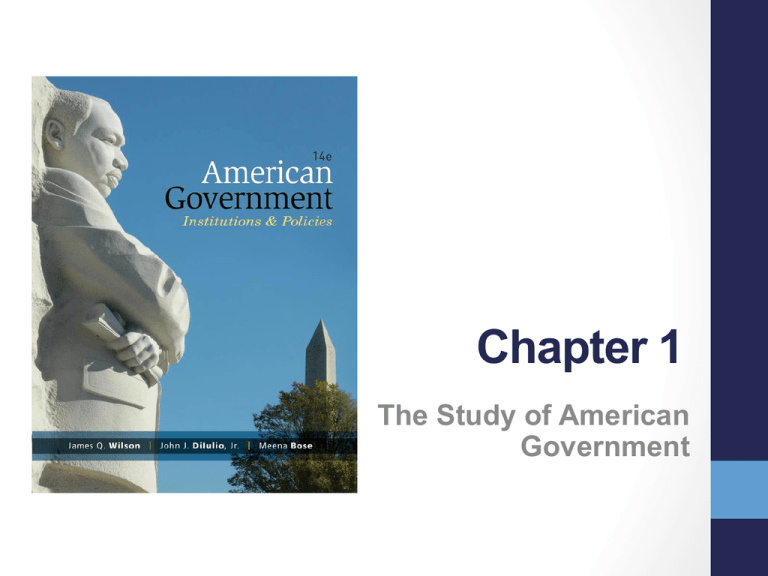
Chapter 1
The Study of American
Government
1. What is meant by “politics”?
2. Can you give two definitions of
“democracy”?
3. How is political power actually
distributed in America?
4. What is the “political agenda” and why
has it expanded?
5. How can you classify and explain the
politics of different issues?
Copyright © 2015 Cengage Learning. All rights reserved.
Learning Objectives
2
Issue: a real or apparent conflict
between the interests, ideas, or beliefs
of different citizens
Copyright © 2015 Cengage Learning. All rights reserved.
Issues and Politics
3
Politics: activity by which an issue is
agitated or settled
Negotiation
Argument
Discussion
Application of force
Persuasion
Copyright © 2015 Cengage Learning. All rights reserved.
Issues and Politics
4
Power: ability of one person to get
another person to act in accordance
with his/her wishes
Copyright © 2015 Cengage Learning. All rights reserved.
Power, Authority, and
Legitimacy
5
Authority: rightful power
Varies from time to time
Varies from country to country
Copyright © 2015 Cengage Learning. All rights reserved.
Power, Authority, and
Legitimacy
6
Legitimacy: political authority conferred
by law or by a constitution
Copyright © 2015 Cengage Learning. All rights reserved.
Power, Authority, and
Legitimacy
7
Democracy: rule of the many
Direct democracy: government in
which most citizens participate directly
Representative democracy:
government in which elected leaders
make decisions
Copyright © 2015 Cengage Learning. All rights reserved.
What is Democracy?
8
1. Class view
Government dominated by capitalists
2. Power elite view
Government dominated by a few top
leaders, mostly outside of government
3. Bureaucratic view
Government dominated by appointed
officials
Copyright © 2015 Cengage Learning. All rights reserved.
Political Power in America:
Five Views
9
4. Pluralist view
Belief that competition among all affected
interests shapes public policy
5. Creedal passion view
Government dominated by impassioned
elites
Copyright © 2015 Cengage Learning. All rights reserved.
Political Power in America:
Five Views
10
Who governs?
1. How is political power actually distributed
in America?
2. What explains major political change?
To what ends?
1. What value or values matter most in
American democracy?
2. Are trade-offs among political purposes
inevitable?
Copyright © 2015 Cengage Learning. All rights reserved.
Who Governs—and to
What Ends?
11
Political agenda: issues that people
believe require governmental action;
affected by
Shared political values
Weight of custom and tradition
Impact of events
Changes in way political elites think and
talk about politics
Copyright © 2015 Cengage Learning. All rights reserved.
Expanding the Political Agenda
12
Americans felt
powerfully connected
to their fellow citizens
in the immediate
aftermath of 9/11.
Copyright © 2015 Cengage Learning. All rights reserved.
Expanding the Political Agenda
13
Groups (organized and unorganized)
Government institutions
Includes courts, bureaucracies
Source of policy (not just reactive)
Media
Action by the States
Copyright © 2015 Cengage Learning. All rights reserved.
Expanding the Political Agenda
14
Type of issue affects politicking
Costs (monetary or nonmonetary)
Benefits (monetary or nonmonetary)
Perception of costs vs. benefits
Is beneficiary “deserving”?
Copyright © 2015 Cengage Learning. All rights reserved.
The Politics of Different
Issues
15
Simple theory of politics:
1. Are costs and benefits of proposed
policy widely distributed?
Income tax, Social Security
2. Are costs and benefits of proposed
policy narrowly distributed?
Farm subsidies
Copyright © 2015 Cengage Learning. All rights reserved.
The Politics of Different
Issues
16
Majoritarian politics
Distributed benefits, distributed costs
Free-rider problem
Example: Social Security
Copyright © 2015 Cengage Learning. All rights reserved.
Four Types of Politics
17
Interest group politics
Usually involves organized interest groups
Concentrated benefits, concentrated costs
Example: regulations affecting layoff
notifications for union members
Copyright © 2015 Cengage Learning. All rights reserved.
Four Types of Politics
18
Client politics
Concentrated benefits, distributed costs
Pork-barrel legislations and log-rolling
Example: farm subsidies
Copyright © 2015 Cengage Learning. All rights reserved.
Four Types of Politics
19
Entrepreneurial Politics
Distributed benefits, concentrated costs
Policy entrepreneurs
Ralph Nader
Example: environmental protection
regulations
Copyright © 2015 Cengage Learning. All rights reserved.
Four Types of Politics
20
Copyright © 2015 Cengage Learning. All rights reserved.
A Way of Classifying and Explaining
the Politics of Different Policy Issues
21
Policy dynamics
Issue can remain stable, change a little or
a lot, change slowly or quickly
No “typical” path
Most major social legislation reflects
majoritarian politics
Copyright © 2015 Cengage Learning. All rights reserved.
Four Types of Politics
22
Copyright © 2015 Cengage Learning. All rights reserved.
Major Overhaul of U.S. Military
Includes Defense Cuts
23
Click picture to play video
Taking a closer look:
1. Which of the four types of politics best
describes defense policy?
2. When formulating this policy, who likely
served as President Obama’s primary
advisors?
3. What can you hypothesize about the
timing of this policy proposal?
Copyright © 2015 Cengage Learning. All rights reserved.
Major Overhaul of U.S. Military
Includes Defense Cuts
24
Political scientists ask how and why
1. Who governs—and to what ends?
2. How do political issues get on the public
agenda?
3. How do the politics of issues change over time?
4. What political obstacles and opportunities will
arise?
5. What is the role of public opinion, interest
groups, the media, the courts and political
parties?
Copyright © 2015 Cengage Learning. All rights reserved.
Understanding Politics
25






